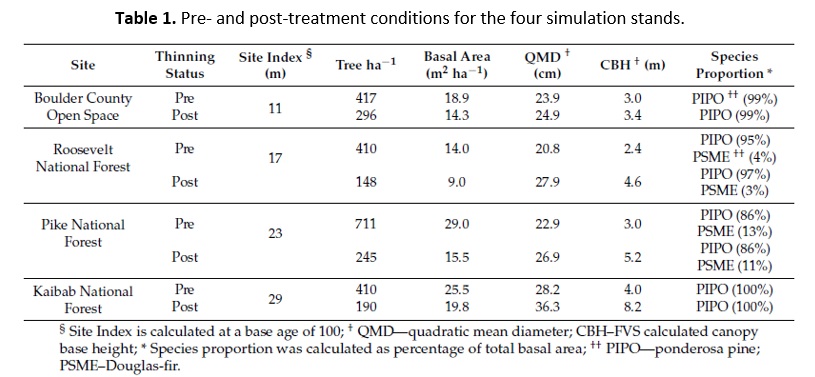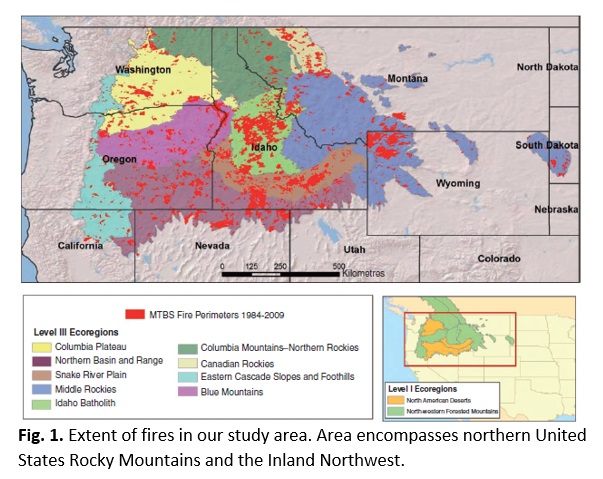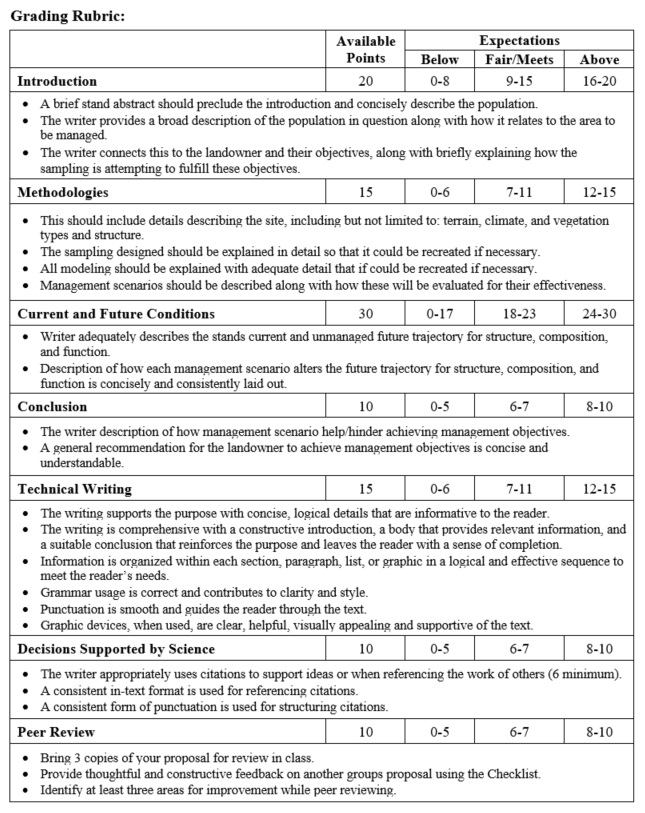Premise: After approval from your boss, you and your field crew implement the inventory design that you developed. Now you need to analyze your inventory of the Ben Delatour Scout Ranch and report back on the current stand structure, composition, and function of each of the stands/cover types to the landowner.
This should include a brief Stand Abstract that describes the current structure and condition of the stand. You can use the following example to help in formatting your own abstract:
Stand 559 – Idaho Experimental Forest
This stand mostly appears as an uneven-aged mixture of western red cedar (Thuja plicata), grand fir (Abies grandis), Douglas-fir (Psuedotsuga menziessi), and western larch (Larix occidentalis), with all species making up both cohorts. The larger cohort ranges from ~24-32” DBH and is approximately 90 years old, while the younger cohort ranges from ~12-20” DBH and is about 65 year old. The only deviation from this mixture is along the ridgeline that runs along the southern stand edge, which is dominated by ponderosa pine (Pinus ponderosa). The site occupies the upper third of a hillslope on 20-30% slopes with a northwesterly aspect. The stand is adjacent to a clearcut harvest performed by Bennett in 2012; this cut has led to an increase in wind-throw damage along the stands southern edge and while preparing site preparation, a fire spread from Bennett property into the southwest edge of the stand, killing about half the younger cohort and culling the butt logs in most the older cohort for an estimated 1.5 acres.
Task: You need to generate a report that summarizes the current and 40 year projected forest structure, composition, and function for the Ben Delatour Scout Ranch utilizing the Forest Vegetation Simulator (FVS). You should compare a default no management option with at least 3 alternative management scenarios. Your comparison should evaluate each management scenario for its ability to meet the combination of management objectives the landowner has laid out. This report should include details of the sampling conducted and site description, this may require you to evaluate sampling and site level information that is imbedded within the FVS data. You must justify the techniques that you use in terms of both efficiency and statistical rigor. Your report to your boss is due by 5:00 pm on Nov. 30th.
Report Instructions: Your report is to be done in groups of no more than 3 people and should be typed using 1.5 line spacing and Times New Roman 12pt font. All included tables, figures, and images must be adequately referenced within the text and be accompanied by a descriptive caption. Bring 3 copies of your report to class on Nov. 26th for peer-review. A printed copy of your report should be submitted to the Instructor’s mailbox by 5:00 pm on Nov. 30th.
Review your report against this checklist to ensure all important elements are covered:
- Abstract
- Summarizes the important points from each section in a sentence or two.
- Follows the arrangement of the rest of the report.
- Stays within a maximum of 200 words.
- Introduction
- Conveys the landowners desired management objectives and the reason why they want to manage for these things.
- Articulates what characteristics need to be assessed to inform the objectives.
- Explain how management simulations can be used to support decision making.
- Linkages to proper sampling design and sample allocation are made within the context of the project and connected to the statistical, managerial, and economic benefits it can provide.
- Methodologies
- Material is appropriately broken out to make it organized and easy to read (i.e. site description, sampling design, management simulations, growth and yield modeling).
- All sample design elements are thoroughly defined so anyone with forestry knowledge could implement the process, including experimental unit, sample size, plot spacing, field navigation between plots, observations to collect, and representative measures for summarizing the data.
- Management scenarios and model parameters are explained with enough detail for the reader to recreate the simulations.
- Management scenarios are connected to the management objectives.
- Current and Future Conditions
- A brief description of the current stand structure, composition, and condition is provided.
- Effects of management scenarios are described for the structure, composition, and condition they are expected to create in 40 years.
- Stand description and management effects are explained using appropriate biometry and silviculture terminology and are supported with evidence from the inventory and simulations.
- The management effects are connected to their ability to help meet various management objectives.
- All necessary jargon is properly defined for non-experts to understand.
- Conclusion
- Briefly summarizes the management strategy(s) best suited to help meet the landowner’s objectives and anything the landowner should consider in moving forward with their management.
- Technical Writing
- Defined formatting expectations are followed.
- Complete explanatory captions accompany tables and figures, and all tables and figures are referenced in the text.
- Consistent formatting is used throughout the document to make it easier for the reader to follow.
- Grammatical and spelling errors are minimized so that they do not distract the reader.
- Decisions Supported by Science
- A minimum of 6 scientific references are used to support statements of fact or connect ideas.
- All citations are correctly and consistently referenced in the text and at the end of the document.
Examples for Citing Literature
– At the end of the document use the following citation conventions:
- Peer-reviewed Journals (multiple authors):
- Carrot, Y.H., Turnip, J.U.H. and Tomato, A.T. (2010). Spectral analysis of mixed vegetables in pies. International Journal of Vegetable Science, 19, 976-983.
- Peer-reviewed Journals (two authors):
- Carrot, Y.H. and Turnip, J.U.H (2005). Soup mixes: a comprehensive review. International Journal of Soup Science, 14, 245-248.
- Peer-reviewed Journals (single author):
- Carrot, Y.H. (2005). Carrots in the vegetable word. International Journal of Carrots, 14, 245-248.
- Books / Book Chapters:
- Carrot, Y.H. and Turnip, J.U.H. (2001). The use of potatoes in soup: a review, in “Soups of the World”, Ed. Fried Potatoes, Wiley-Blackwell, pp 67-79.
- Agency Reports:
- Carrot, Y.H., Turnip, J.U.H. and Tomato, A.T. (2010). Review of soup quality standards within the National Park Services’ cafeterias. NPS report, USA, pp 46
– To reference an article in the text as someone saying something:
- As we can see from Carrot (2002), the choice in soup mix is very important
- Carrot et al. (2002) tell us that the freshness of vegetables influences the soup.
- This is supported by Carrot and Potato (2002) who showed how vegetable freshness impacts acidity.
– To attribute a statement in the text to an article:
- Single Author:
- The quality of a soup is impacted by the freshness of the vegetables (Carrot 2002).
- Multiple Authors:
- The acidity of a soup is impacted by the freshness of the vegetables (Carrot et al. 2002).
- Multiple Citations:
- Vegetable freshness impacts the acidity and quality of a soup (Carrot 2002; Carrot et al. 2002).
Examples of Figures and Tables


As with all technical writing, the ability to write clearly and concisely will be considered in the evaluation of your proposal. Additionally, you are expected to properly support and justify your statements about forest management, your methodologies, and statistical approaches with literature citations.

Code of Conduct: Do not copy and paste material from these instructions, papers, or books when writing your essay, the only exception is that the provided maps may be reused. Attempt to rewrite in your own words the message you want conveyed and then provide proper citations. Failure to do so will result in a score of 0.
